The words “fall back” can mean to recede, withdraw or retreat – like what happens to our gardens at this time of year. Fall back is also a catchy phrase we use to remind ourselves which way to adjust our clocks when moving from daylight time to standard time. Either way my friends, gardening season is over – the autumnal equinox officially ushered in fall on September 22nd, and in less than 2 weeks it will be time to turn our clocks back. For me, this turning of the clocks, more than any other temporal landmark, signals winter’s imminent approach; when we’ll trade our garden gloves for ski gloves, and hot toddies by the fire will replace chilled wine on the patio.
We could choose to lament the passing of another garden season, or we could celebrate what’s still beautiful in our gardens, while it’s there. If you find there’s little or no beauty left in your garden, you might want to consider adding some plant material specifically for fall colour – late or long blooming perennials, foliage that changes or intensifies its colour, plants with ornamental fruit and of course some evergreen material to set it all off.
Let’s take a walk along our city streets to see what autumn splendour we can find.
Trees
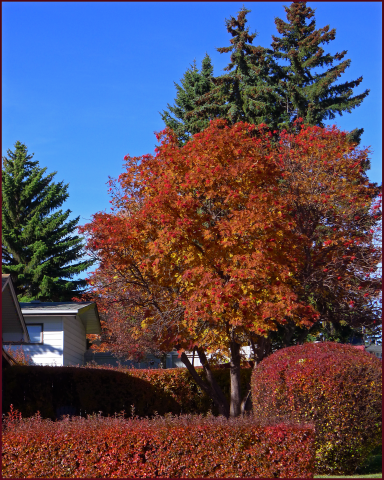
Mountain ash turns intense shades of tawny red.
Photo: Sue Gaviller
Among the most dramatic fall colour displays is the mountain ash, with foliage hues of orange, red and mahogany, and bright red or orange berries.
The American mountain ash (Sorbus americana) and showy mountain ash (Sorbus decora) have big clusters of true red berries, which are very showy.
The European mountain ash (Sorbus aucuparia) has smaller berries that are more orange and is one of the last trees to turn colour in the fall.
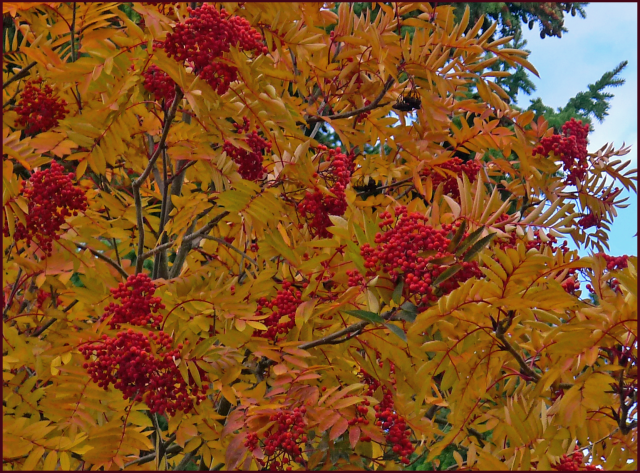
Sorbus americana beginning to change colour. Photo: Sue Gaviller
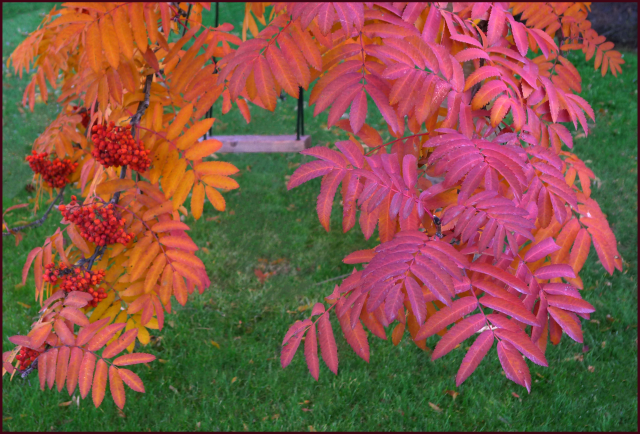
A make-shift swing hangs from the branches of a colourful mountain ash. Photo: Sue Gaviller
Many species of Malus (apple, crabapple) also have excellent fall colour, for example; the small weeping ‘Rosy Glo’ turns brilliant orange, and the stately ‘Pink Spires’ turns flaming red. Others display more golden tones which contrast beautifully with the red fruit.
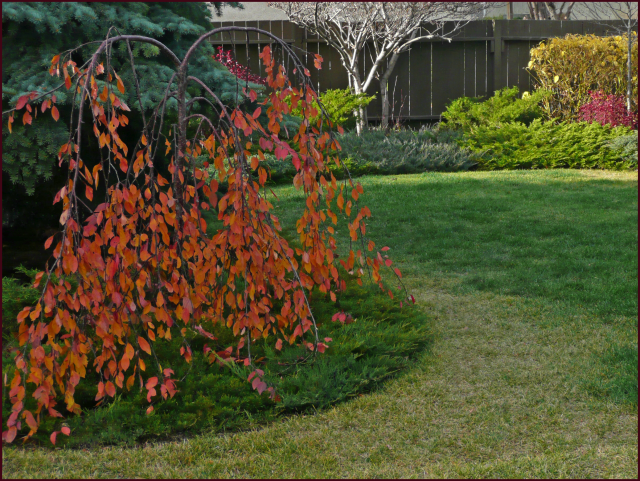
Malus ‘Rosy Glo’. Photo: Sue Gaviller
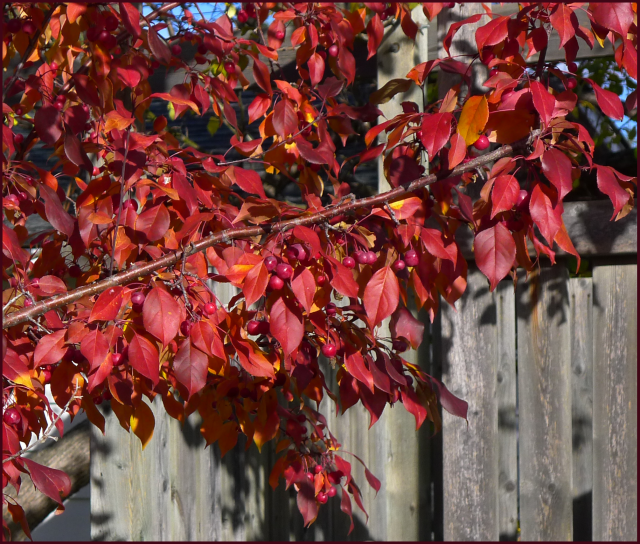
Malus sp. Photo: Sue Gaviller

Malus sp. Photo: Sue Gaviller
Betula (birch) too, present shades of gold, and Acer, the maple genus, includes some of the best fall colour specimens – unfortunately the gorgeous sugar maple, that king of autumn foliage, isn’t hardy here in the prairies. However, Acer ginnala (Amur maple) does well here and has fabulous fall colour. Its growth habit can be somewhat untidy when grown as a tree – it is therefore in my opinion, best grown as a large shrub.
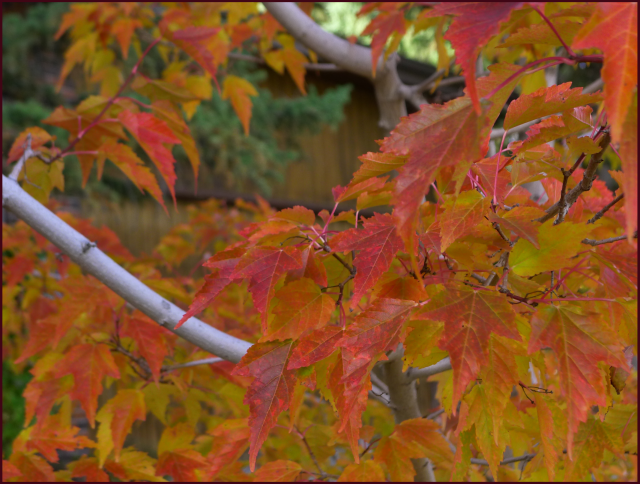
Acer ginnala. Photo: Sue Gaviller
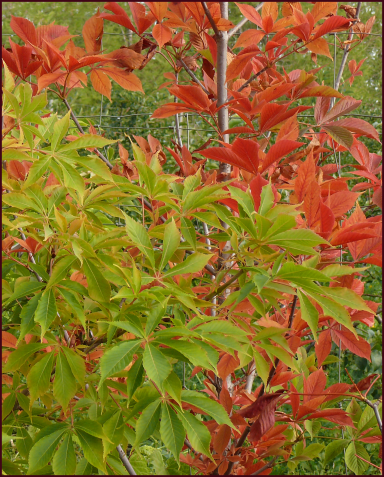
Aesculus glabra – several young specimens in various stages of autumn colour change. Photo: Pat Gaviller
There are of course many other trees with colourful fall foliage: Aesculus glabra (Ohio Buckeye) produces stunning orange fall colour, as does Amelanchier grandiflora ‘Autumn Brilliance’ (Autumn Brilliance serviceberry).
Larix (larch) and Populus (aspen/poplar) turn golden-yellow, and the foliage of Crataegus (hawthorn) changes to yellow, amber, orange or burgundy in the fall – the display is short-lived, but they also set pretty fruit.
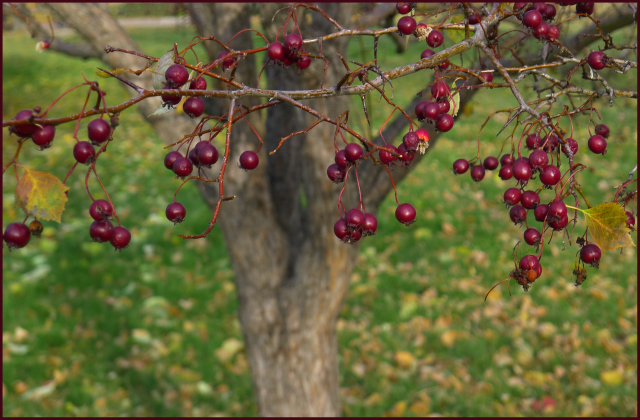
The berries of Crataegus sp. are quite decorative. Photo: Sue Gaviller
Shrubs
There are countless shrubs that offer fine fall colour. Currently the most obvious is the ubiquitous Cotoneaster – I must admit I have a love-hate relationship with this shrub. What I don’t like is that I’ve inherited it – a hedge and 2 shrubs, positioned such that they require weekly pruning. Cotoneaster is prone to pests and disease (aphids, oyster shell scale, fire blight, twig blight), and the constant pruning makes it that much more susceptible. If mine had been situated differently, with more elbow room to reach their natural spread, I’d happily accept their presence in my yard. So why don’t I just remove them you ask? Well, the two shrubs are on city property and the hedge is a monster – I can’t even image the herculean effort required to remove it, or the impact it would have on the gardens. So I’m kinda stuck with all of them.
But I digress. Cotoneaster isn’t all bad – I love that it leafs out early in the spring, with dark green glossy leaves. I love that it attracts many species of birds, and I love the vibrant autumn foliage.
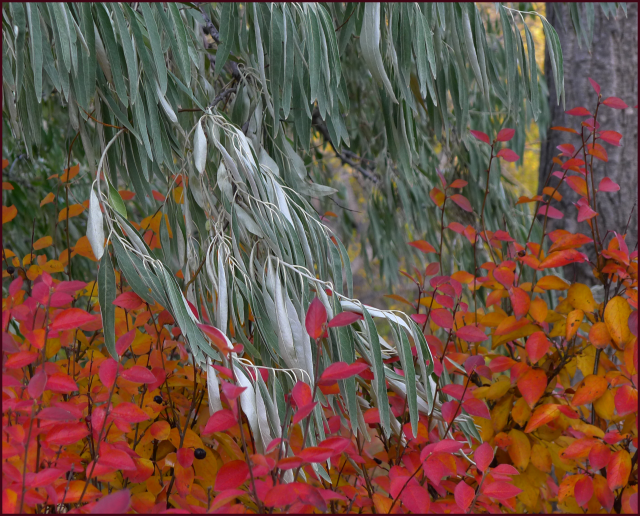
Brilliant hues of Cotoneaster lucidus foliage are a spectacular contrast to the silvery leaves of Elaeagnus angustifolia. Photo: Sue Gaviller
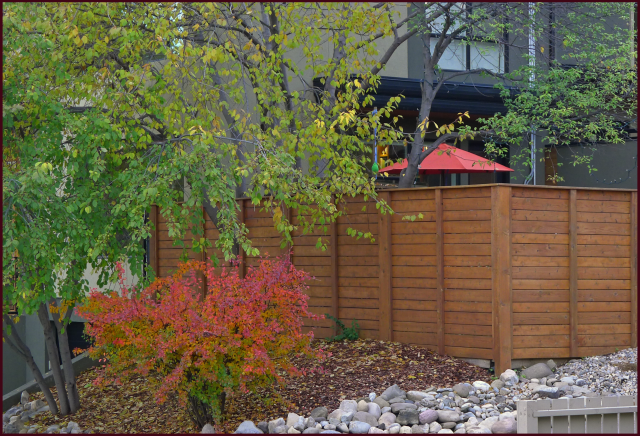
Bright orange Cotoneaster foliage echoes the colour of the patio umbrella. Photo: Sue Gaviller
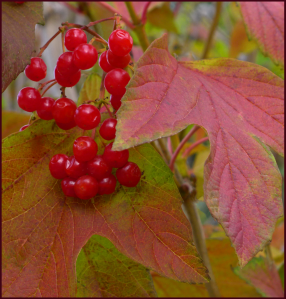
Viburnum trilobum. Photo: Sue Gaviller
Most species of Viburnum (nannyberry, highbush cranberry, arrowwood) also provide rich autumn colour (attractive fruit too), and the normally unassuming Euonymus alatus (burning bush) becomes show-stopping fuchsia-red in the fall. Many Cornus (dogwood) species turn various shades of red, contrasting nicely with the white berries and Spiraea (spirea) takes on fiery orange-red tones. There are even a couple of lilacs that display colourful fall foliage – Syringa patula ‘Miss Kim’ being the most notable.
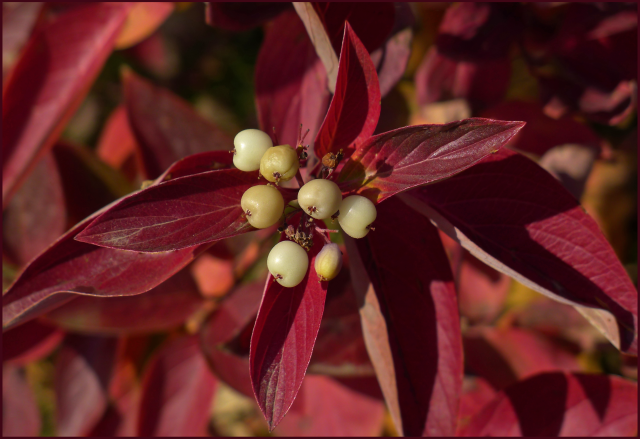
Cornus sericea. Photo: Pat Gaviller
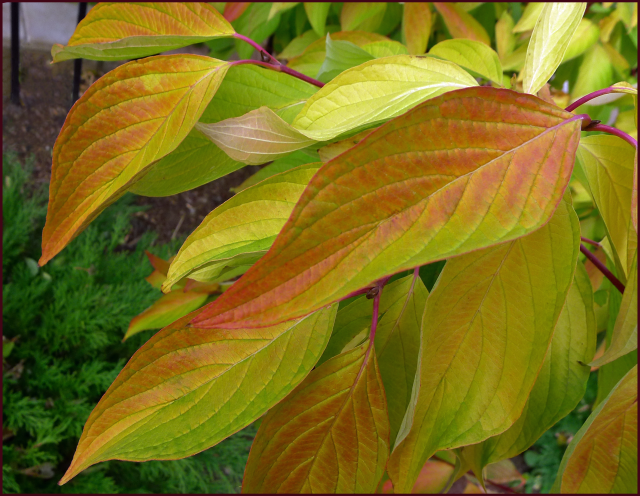
Cornus alba ‘Aurea’ fall foliage. Photo: Sue Gaviller
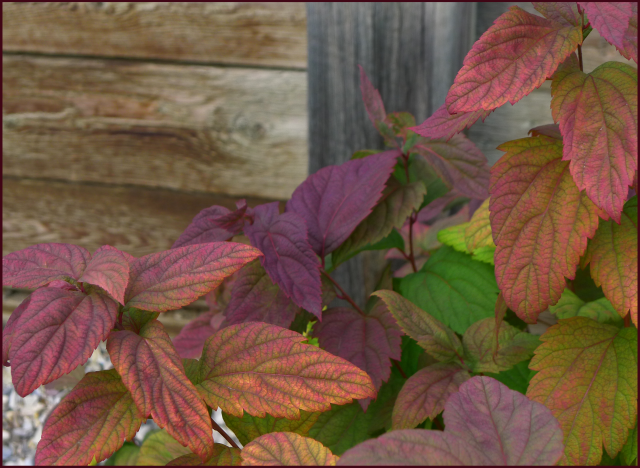
Spiraea japonica ‘Macrophylla’ exhibits beautiful shades of orange, red and purple in its fall foliage.
Photo: Sue Gaviller
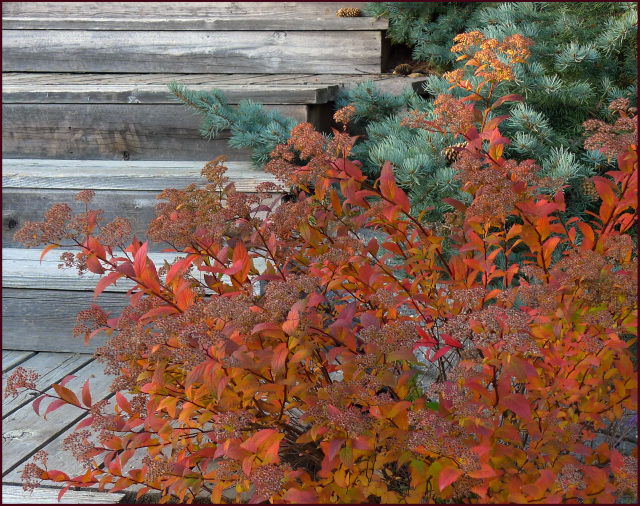
The orange-red autumn foliage of Spiraea japonica ‘Gold Flame’ is set off beautifully by the steely blue of the spruce. Photo: Sue Gaviller
Some shrubs have no appreciable fall foliage colour to offer, instead providing a punch of colour with their fruit. Hippophae rhamnoides (Sea Buckthorn) has gorgeous orange fruit, Sambucus racemosa (red elder) produces beautiful red berries, Symphoricarpos doorenbosii ‘Amethyst’ (coralberry) has pretty pink berries and many roses produce very showy hips.
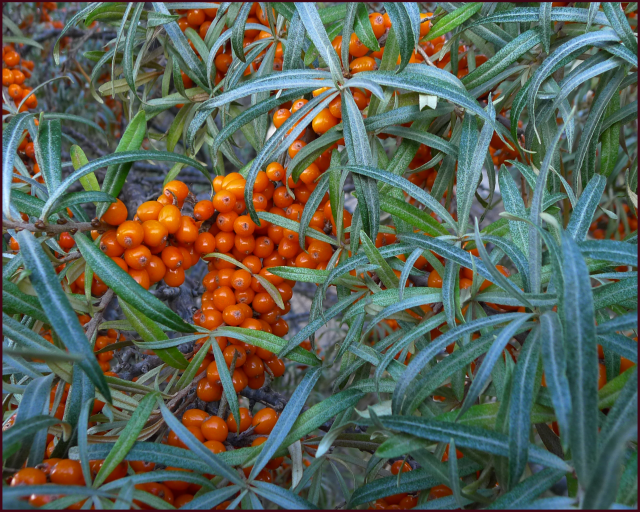
Hippophae rhamnoides berries. Photo: Sue Gaviller
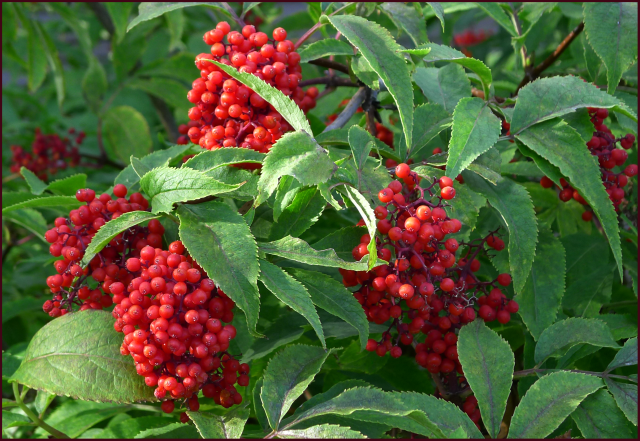
Sambucus racemosa berries. Photo: Sue Gaviller
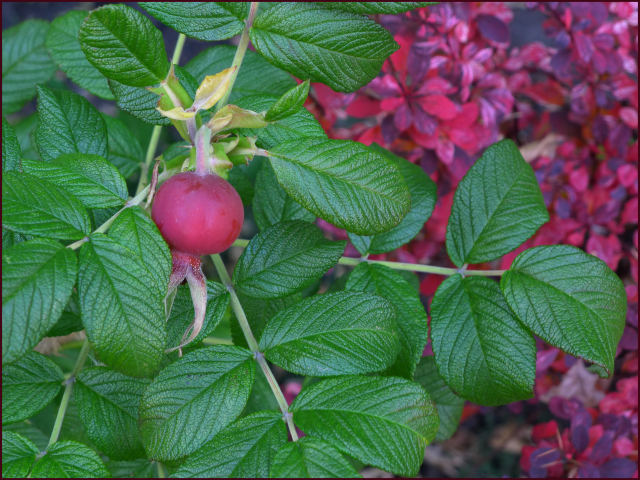
Rosa ‘Scabrosa’ produces huge cherry-red hips. Photo: Sue Gaviller
Perennials
Although herbaceous perennials by definition, die back at the end of the season, some have foliage that changes or intensifies its colour first. For example Paeonia (peony) foliage often takes on reddish tones, as does Bergenia (elephant ears), particularly the cultivar ‘Bressingham Ruby’. Arctostaphylos uva ursi (kinnickinnick), an evergreen groundcover, turns mahogany-coloured in the fall, and Ajuga reptans (bugleweed), which is semi-evergreen, intensifies its already dark hue, taking on a rich opalescence with fall’s cooler nights. Many Heuchera cultivars are also still colourful, again their foliage assuming darker, richer tones.
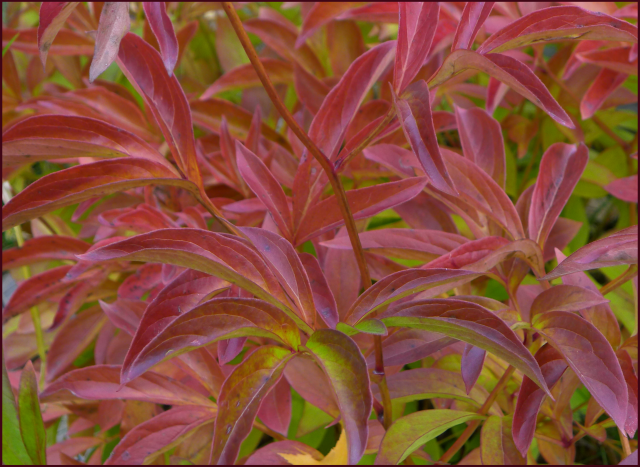
Peony fall foliage. Photo: Sue Gaviller
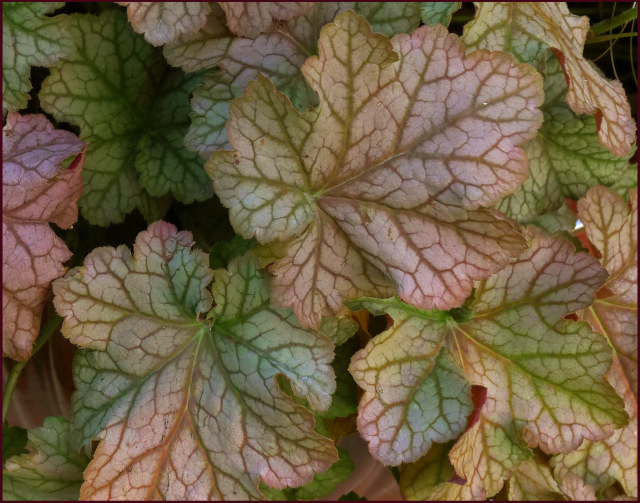
Heuchera ‘Pinot Gris’ still looking beautiful, its autumn foliage displaying very prominent veining. Photo: Sue Gaviller
There are even a few perennials still blooming – some are season-long bloomers; for example in my own garden, Geranium cinereum ‘Ballerina’ (Ballerina cranesbill) has a few stray blooms, as do Campanula portenschlagiana (Dalmatian bellflower) and Dianthus ‘Neon Star’ (Neon Star pinks), both profiled in a post from last year, Top Twenty of Twenty Twelve. There are also late bloomers that offer fall colour – Aster, Anemone hupehensis (Japanese anemone), Hylotelephium telephium (tall stonecrop) and Chrysanthemum (mums) to name a few. Even my Eutrochium purpureum (formerly Eupatorium purpureum and better known as Joe Pye Weed) still has a hint of colour.
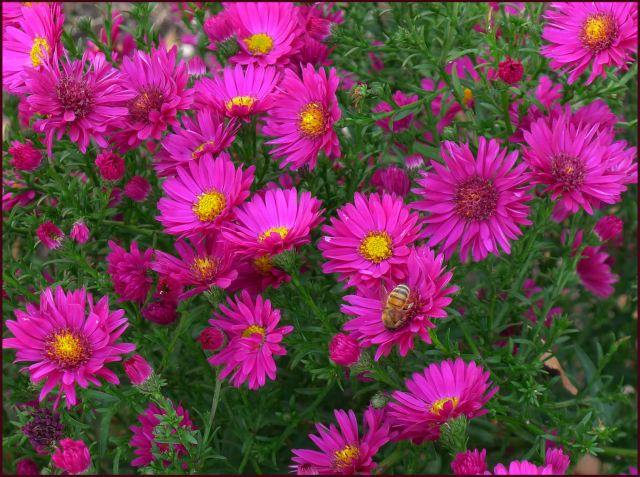
Aster novae-angliae ‘Alma Potschke’. Photo: Sue Gaviller
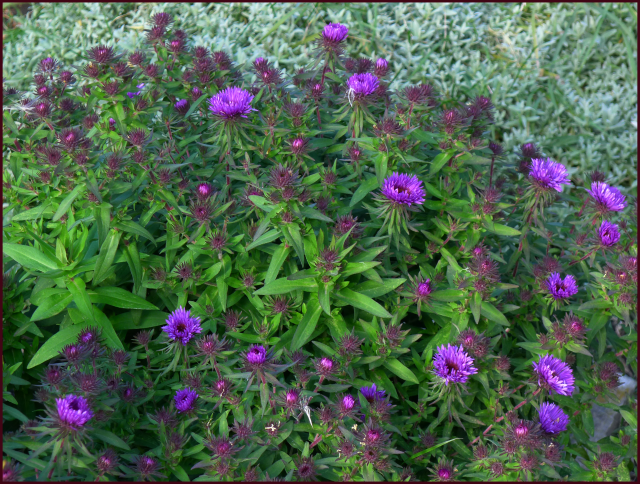
Aster novae-angliae ‘Purple Dome’. Photo: Sue Gaviller

Hylotelephium telephium ‘Autumn Joy’. Photo: Sue Gaviller
Ornamental grasses look stunning at this time of year – tall Calamagrostis cultivars (reed grass), with their straw-coloured inflorescence, nicely complement other autumn hues, and blue grasses like Helictotrichon sempervirens (blue oat grass) and Festuca glauca (blue fescue) offer cool contrast.
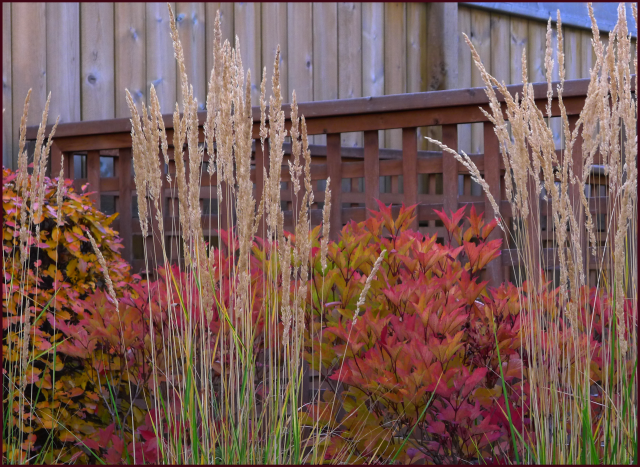
Calamagrostis ‘Avalanche’ beautifully complements Cotoneaster (left) and Viburnum trilobum ‘Bailey Compact’ (middle). Photo: Sue Gaviller
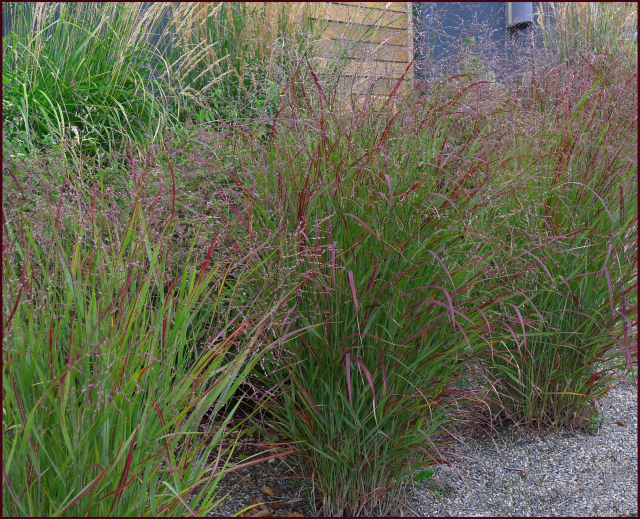
Blades of Panicum virgatum ‘Shenandoah’ turn rich red in autumn. Photo: Sue Gaviller
Autumn can be a beautiful time in the garden – for most plants it’s their last hurrah before winter sets in. Be sure to include some of these colourful fall plants in your garden composition – it will take the sting out of summer’s end.
Happy fall y’all, SueRelated articles
- Autumn Gold (thescottishcountrygarden.com)
- Berried Treasures-Planting the Best Berried Shrubs for Your Fall Garden (thegardendiaries.wordpress.com)
- Big Picture Foliage Color (fine-foliage.com)
© Sue Gaviller and Not Another Gardening Blog 2012. Unauthorized use and/or duplication of this material without express and written permission from this blog’s author and/or owner is strictly prohibited. Excerpts and links may be used, provided that full and clear credit is given to Sue Gaviller and Not Another Gardening Blog with appropriate and specific direction to the original content.







